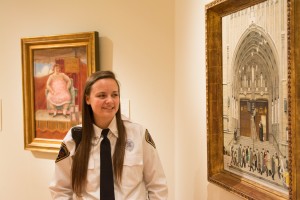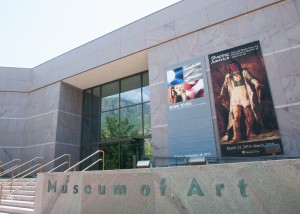Rachel Dorius typically stands apart from the crowd in her security uniform. She watches over the many art enthusiasts who fill the exhibit and chatter excitedly about the pieces hanging on the wall. Dorius’s main task is to make sure the guests enjoy their experience without getting too close.

Thousands of guests attend BYU’s Museum of Art each month, visiting on field trips and family nights. The MOA, like other museums, has to carefully plan its security to ensure the art is safe and undamaged.
Jeff Strong, the MOA’s directing supervisor of security, said the museum wants to strike a balance between art security and patron experience. Other museums go to extreme measures to protect art, he said, but the MOA allows guests to see the works up close. That means the museum staff is the primary defense against damage and theft.
“We’re trying to create a positive experience for the patron,” Strong said. “We get concerned about the overall view and experience, but everyone here has a security mindset. So security doesn’t come just from myself or my division of security officers.”
The museum has set up almost 150 cameras inside and outside the building, but most of the MOA’s pieces aren’t protected by Plexiglas, which can occasionally cause security problems.
“Our largest day-to-day concern is accidental damage,” Strong said. “There have been a couple incidents of accidental scrapes. Someone could accidentally trip. Things like that happen.”
An older woman once pointed too closely at an oil painting on canvas, Strong said. The woman’s fingernails were sharp enough to leave a six-inch mark on the surface of the paint, and the museum had to pay an art conservator $10,000 to repair the damage.
Dorius, a student security guard, said she tries to treat visitors as respectfully as possible, even when they stand closer to the paintings than they should.
“I generally say, ‘Hey, could you scoot back a couple steps?'” Dorius said. “I try to be as nice as I can because it’s all about customer service. I try to make them aware that they’re a little too close.”
Dorius said her uniform sometimes intimidates MOA guests, but the guards don’t want to get in the guests’ way. The security guards are there to help, she said.

“Everything we do is for the guests and the art,” Dorius said. “We don’t want the guests to get in trouble, and we don’t want the art to get damaged.”
Preventing damage is only part of the reason the MOA hires student security guards. The guards are also there to remind patrons of museum etiquette: no backpacks in galleries, no photography in certain collections and no sketching without registering first.
Art theft is another worry for museums, but Strong said the MOA’s pieces are never stolen from exhibits. He’s more concerned about how the museum protects the art that isn’t on display. Storage areas are on the bottom level of the building, and authorized employees have to swipe their ID cards to get inside.
“It’s really restricted on who can even get into the art storage areas,” Strong said. “Our director and associate director don’t even have access to them. My security guards don’t have access there.”
Only the registration department is allowed into all the storage areas, Strong said, and only at certain times of the day. The security cameras run 24/7, the MOA turns on its alarms every night and University Police can respond quickly in case of an emergency.
Security is much more stringent today than it once was, according to Strong. BYU used to store its art collections in the Harris Fine Arts Center, and thieves stole more than 900 pieces over the years. An Impressionist painting titled “Silver Chalice with Roses” disappeared sometime between 1970 and 1985, but no one discovered the theft until 1986. The painting, meanwhile, traded hands between several art dealers and finally came to rest in a Swiss baron’s estate. The baron refused to return the painting, so “Silver Chalice with Roses” didn’t come back to Provo until 2012, years after the baron’s death.
The university’s art is better protected now, Strong said. The MOA opened in 1993, allowing the staff to keep better track of pieces, and security technology has improved as well. Student security guards do their part to prevent damage to the art as guests enjoy relatively close proximity to the pieces on the wall.
“American Chronicles: The Art of Norman Rockwell” is currently the museum’s largest exhibit and will remain open until Feb. 13. Tickets are available at rockwell.byu.edu/tickets.




